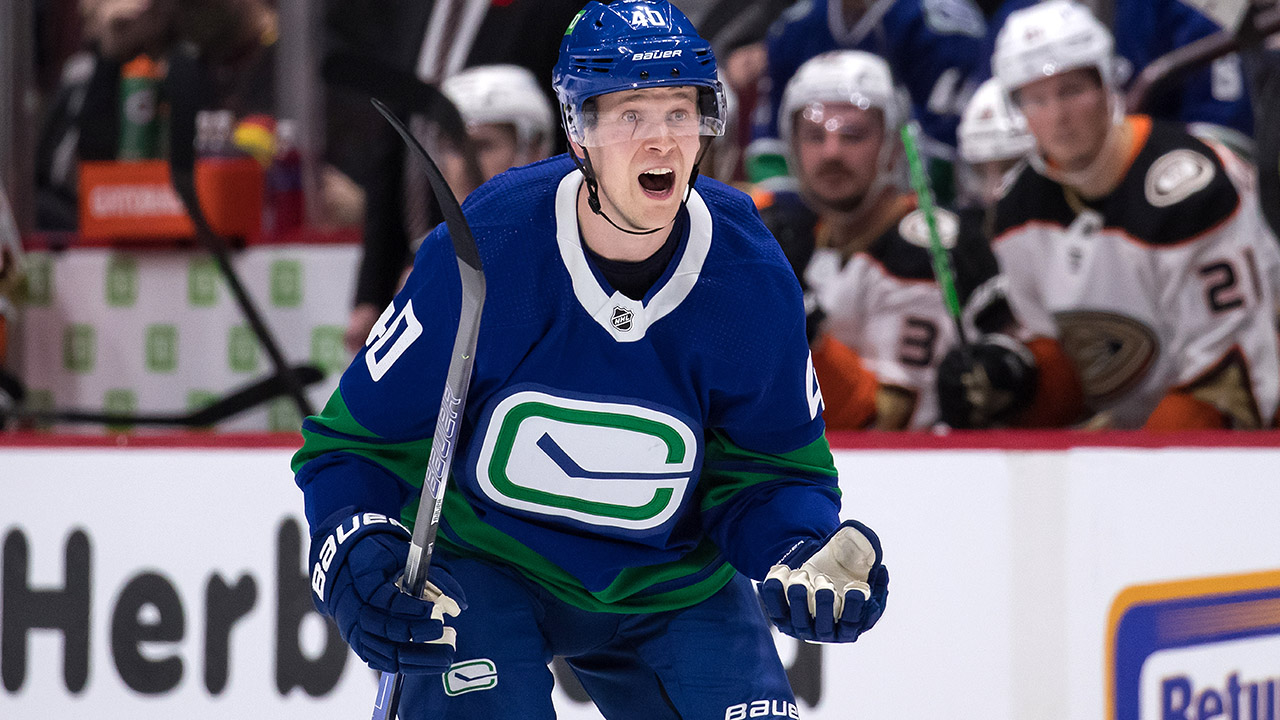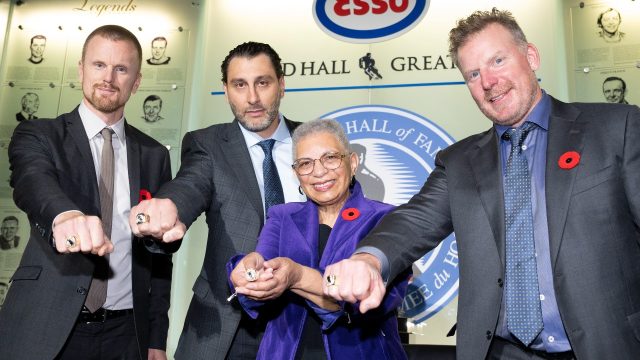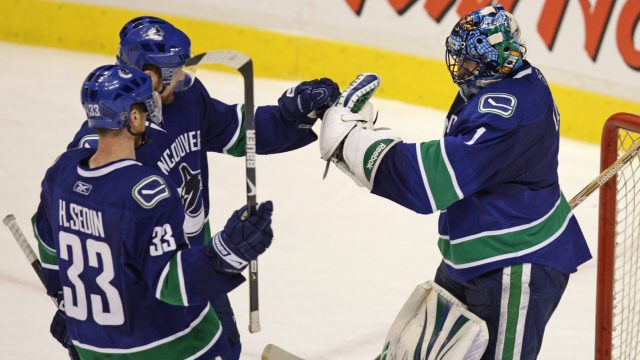
TORONTO – Everyone has a before and after.
No matter what you do, if you learn from your experiences and evolve and grow as a person, you are better and smarter at the end than you were at the beginning. Professional athletes – the good ones – are like that.
But few have had an evolution as dramatic and unforeseen as what Henrik and Daniel Sedin achieved. They began their National Hockey League careers slow, physically-weak and belittled, and are ending them with induction Monday into the Hockey Hall of Fame as the greatest players in Vancouver Canucks history.
Fewer people still have had so clear a turning point, that definable moment when they crossed the canyon separating the “before” and “after” parts, as the Sedins did in 2005.
So much has been written about the Swedish twins, who combined for 2,111 points over 17 seasons in Vancouver, that their development story is well known. It should be a blueprint for current Canucks.
But that unmistakable moment of change for the Sedins, when like a continental divide all the water running in one direction suddenly shifted and started flowing the other way, remained largely unreported.
That’s the way everyone involved intended it when the trajectory of both the twins and the Canucks franchise shifted seismically after an extraordinary July summit in London, England, 17 years ago.
For parts of two days, the Sedins, agent J.P. Barry, Canuck general manager Dave Nonis and coach Marc Crawford met in London’s West End to talk about the forwards’ concern over their roles and whether, if they continued to improve, there would be room for them to grow into core players in Vancouver.
“In a sense, the Canucks were close to losing them because they weren’t being utilized,” Barry told Sportsnet on Thursday. “And if they decided that this wasn’t going to work, you knew they were not going to change their minds.
“I don’t think their unhappiness came up until they went home (during the 2004-05 lockout). It was like, maybe this isn’t the right team for us. Maybe they don’t really value us. And that’s what it came to. It was like a crossroads.”
During the pre-lockout season of 2003-04, the Canucks were still being led by the formidable West Coast Express line of Markus Naslund, Brendan Morrison and Todd Bertuzzi. After scuffling through their first three NHL seasons, the Sedins were second-line players getting third-line ice time under Crawford.
Daniel had 18 goals and 54 points despite average ice time of just 13:33. In the pre-analytics age, his 2.56 even-strength points-per-60-minutes put him among the NHL scoring leaders as the dead-puck era was ending. Henrik Sedin had 42 points in 76 games while averaging 14:02.
Restricted free agents a couple of months shy of their 25th birthdays, four years into their careers and having endured much criticism and derision before (and after) turning themselves into solid NHL players, the Sedins simply wanted to know in the summer of ’05 if they had reached a glass ceiling with the Canucks.
“We had been struggling for so many years when we didn’t seem to be able to take that next step,” Henrik explained last week. “We felt like we wanted more responsibility, and we just wanted them to know that, too — that we felt that we could contribute more.”
“We wanted to show that we wanted to take the next step here,” Daniel said. “For Marc, who had been with us so long, I think he needed to hear that.”
Barry had contacted Nonis to tell him about his clients’ concern and the Sedins’ request for a meeting.
“Dave and I talked it through and, obviously, he realized, like, ‘We can’t lose these guys,’” Barry said. “I never did ask for a trade and Dave didn’t want us to get to that point. But we weren’t going to sign another contract until we knew we were on the same page.”
“He called me and said the twins would really like to sit down with you and Marc and discuss the future,” Nonis recalled. “What did we see going forward? They didn’t want it to be like an adversarial thing. . . so we said, ‘Let’s do it somewhere neutral.’ We ended up going to London.”
Nonis and Crawford flew to London together, game-planning en route. Barry travelled from Canada a day earlier to brief the Sedins, who made the short flight to London from Stockholm.
“I didn’t realize that there was a problem until that point,” Crawford said. “Dave kind of came to me — and I give Dave a lot of credit — and said: ‘We have to straighten this out. You have to straighten this out.’ I didn’t understand why they were upset. Daniel and Henrik were always such polite, great guys. And even the times that I had given them crap, they were respectful. They shouldn’t have been as respectful as they were. But you’re absolutely right, that was a turning point for them.”
The talks were conversational, amiable and it was quickly apparent to all that both sides wanted the relationship to grow. After meeting at their posh hotel – Barry believes it was during Wimbledon because there were tennis players everywhere – they agreed to go for a walk and some fresh air and ended up in a café at famous Harrods Department Store in Knightsbridge. Later, they had pints in a London pub.
“The discussion was never about ‘I want more,’” Nonis said. “It was: ‘If we show you that we can do more, we want to know that it’s there for us. We believe that we can do more and be building blocks, not just complementary pieces.’ It was a very refreshing conversation, a great conversation. I think it was a pivotal part of them moving forward from good players to elite players.”
“They became men,” Crawford said. “Their desire to show that they weren’t happy with the way things were, I think, was a huge growth thing for them. All of a sudden, they weren’t the Sedin twins, the young guys, anymore. By the end of that next year, they were our best players.”
Nobody involved said anything publicly about the meeting.
“I didn’t want any part of that going public,” Nonis said. “There’s revisionist history everywhere. Everyone likes to say that Daniel and Henrik got great support from everyone, but it’s just not true. You know what they went through. It could have been perceived that they were making demands. . . but that wasn’t what the meeting was about.”
Barry: “We tried to keep it quiet. We didn’t want it to be a big story.”
A month after the summit, the Sedins agreed to one-year contracts and in 2005-06 their playing time increased about three minutes per game and they had breakthrough seasons offensively. Henrik had 75 points and Daniel 71, behind only Naslund’s 84 points.
When the Canucks missed the playoffs, Nonis fired Crawford as coach and promoted Alain Vigneault to replace him. That summer, Nonis also traded Bertuzzi to the Florida Panthers for goalie Roberto Luongo, who, incredibly, is going into the Hall of Fame with the Sedins.
Vigneault made the Sedins first-liners and for the next decade, the Canucks were Danny and Hank’s team. They drove performance and culture, winning NHL scoring titles and MVP trophies and helping the Canucks to the Stanley Cup Final in 2011. By then, Nonis had been replaced as GM by Mike Gillis.
Nobody, including Daniel and Henrik, envisioned any of that as they scuffled through their first three seasons. They actually got booed in Vancouver, and even many in the media reprehensibly derided them as the “sisters.”
“In any profession, if you don’t live up to expectations or feel like you’re even close to being where you feel like you should be, there is self-doubt, absolutely,” Daniel said. “Until you realize that this is going to take time and it’s going to take hard work. . . until you realize that, it’s tough to make the changes necessary. I think sometimes you have to reach the bottom to realize that. Where we were at in our situation, we were obviously in a low place.”
Henrik said: “There were a lot of tough nights for sure laying in bed knowing that you’re coming into another game and at risk of getting booed. For sure, confidence was a big part. If you think about it, for us to step on the ice and play against the top players in the world and us feeling inside that we’re not physically ready to play in the league… I think that’s what we felt for the first three or four years until we caught up (in speed and strength). Preparation, that’s how you get confidence in this league — knowing that you’ve done everything to be ready when you step on the ice.
“We got stronger, No. 1. And we became much better skaters. As soon as we felt that we could compete physically with all the guys and skate with all the guys, I think we were able to get back to playing our game. I think we got away from that early where, for us, it was more dump and chase and just trying not to get scored on.”
The Canucks’ training staff actually devised a Sedins Workout, a game-day staple of gym sessions in the morning. Henrik said it started in their second season, 2001-02, because it was obvious that summer training alone was not going to get the brothers into NHL condition.
“It was just me and Danny,” he said. “I still remember on road trips, we would go down to the hotel gym and do a workout. You didn’t feel embarrassed, but, like, it was weird for you to go out and do that on a game day. But after a few weeks, you felt a difference and you took pride in that.
“We were not fat, but our body-fat percentage was not great. The one thing we had going for us was our cardio was really, really good. Our heart, our ability to do work, was really good.”
“We could skate forever,” Daniel said. “But we weren’t fast and we weren’t strong enough. That was a learning curve for sure. It was probably our third summer where we kind of realized that if we’re going to do this, we’ve got to start working.
“I think it was huge for us to go through that because we had that mindset until we retired: we need to take it day by day and try to get better.”
Daniel said he and his brother probably should have started their careers in the American Hockey League instead in the NHL as 20-year-old rookies. Back then, he said, the Hall of Fame would have seemed laughable; they were just trying to survive.
“We were quiet guys,” Daniel said. “We didn’t ask a lot of questions, but we really watched other people and how they acted. And we took all the good things that we found, even some of the bad things — like, okay, I’m not going to do that – and I think we were able to learn on the fly and put them into our lives and our careers. Take ownership of your own play, do extra in the gym, be the best prepared player you can be because it gives you confidence. All those things coming together is what made us the best we could be.
“That’s what I’m most proud of: we became the best players that we could be. I can regret that we weren’t great early on, but we became the best players we could be.”
Hall of Famers.







